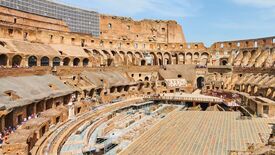CONSERVATION CORNER
A weekly blog for all things conservation
 Tourists visit Rome's Colosseum in June 2019. EyesWideOpen/Getty Images Tourists visit Rome's Colosseum in June 2019. EyesWideOpen/Getty Images Patrick Cullen, BCCD, District Engineer Let’s talk about Rome. (Pull this one out at parties to impress your family and friends!) Roman concrete is world renowned for its strength and durability. People are often perplexed why the Romans could’ve built such durable structures that have last 2,000yrs and we can only get a fraction of that. Scientist have spent decades trying to recreate the Romans’ formula for their concrete. And so far, they have identified some key factors. 1. The Romans used a significant amount of limestone.
2. They heated the mixture. 3. They utilized seawater. 4. They were very selective with their materials. While I'm not certain about the exact importance of factors 3 and 4 for the Romans, the presence of limestone and warm water is a significant factor. When concrete ages, it tends to develop cracks that grow over time, eventually leading to failure. But when you have an extra amount of Limestone in your mix, your concrete will self-heal when water activates it with a chemical reaction. (After a rain event) This means that Roman concrete contains unreacted limestone that can expand and create new concrete to fill the cracks, resulting in self-healing. The following is an excerpt from an MIT article listed below. ““The benefits of hot mixing are twofold,” Masic says. “First, when the overall concrete is heated to high temperatures, it allows chemistries that are not possible if you only used slaked lime, producing high-temperature-associated compounds that would not otherwise form. Second, this increased temperature significantly reduces curing and setting times since all the reactions are accelerated, allowing for much faster construction.” During the hot mixing process, the lime clasts develop a characteristically brittle nanoparticulate architecture, creating an easily fractured and reactive calcium source, which, as the team proposed, could provide a critical self-healing functionality. As soon as tiny cracks start to form within the concrete, they can preferentially travel through the high-surface-area lime clasts. This material can then react with water, creating a calcium-saturated solution, which can recrystallize as calcium carbonate and quickly fill the crack, or react with pozzolanic materials to further strengthen the composite material. These reactions take place spontaneously and therefore automatically heal the cracks before they spread. Previous support for this hypothesis was found through the examination of other Roman concrete samples that exhibited calcite-filled cracks.” (David L. Chandler) Why don’t we do this? Because the Romans didn’t use rebar and this chemical reaction is corrosive and will cause the Rebar to corrode and break. While concrete is very strong in compression, it is very weak in tension (when subjected to pulling forces), which is where rebar comes into play. Currently, the weakest link in our concrete is the rebar we use. So, for now, the concrete’s lifespan will be limited by the rebar we use for support in the concrete. If you're interested in learning more about this topic, you can check out this article: https://news.mit.edu/2023/roman-concrete-durability-lime-casts-0106 The Bradford County Conservation District is committed to helping people manage resources wisely. You can visit the Bradford County Conservation District at 200 Lake Rd in Wysox across from the Wysox Fire Hall. Contact us at (570) 485-3144 or visit our web page at www.bccdpa.com.
0 Comments
Leave a Reply. |
AuthorsVarious staff at the Bradford County Conservation District Archives
July 2024
Categories
All
|
|
Bradford County Conservation District
Stoll Natural Resource Center 200 Lake Road, Suite E | Towanda PA 18848 Phone: (570)-485-3144 |
